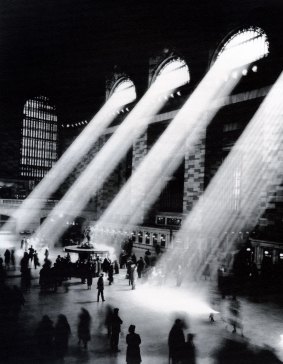This was published 8 years ago
Slow travel: It's about the journey, not the destination
By Lee Tulloch
When we say "long haul" nowadays we're talking about 24 hours flying time. Often we do it in a monstrous jet in which we barely feel any turbulence. But think about what that might have meant in the past.
Over the last few years, besides gallivanting around the world in large aircraft, I've been writing a novel set in the 1920s and 1930s. That means I've had to do a significant amount of research about how people travelled in the early days of leisure transport and commercial aviation.
In the late 1930s, if you had the wherewithal to fly from Sydney to London, you may have done it on a luxury Empire Class flying boat, a journey which took eight days, with 31 stops for refuelling, including Brisbane, Darwin, Surabaya, Singapore, Rangoon, Karachi, Basra and Cairo. The plane lumbered along at 160 miles an hour.

New York's Grand Central Station main hall in 1930.Credit: Alamy
The upside was that there were only 15 passengers, you could get up from your lounge chair and roam around (or smoke) at any time, and there was an observation deck. And imagine how exhilarating it would have been to have visited exotic Surabaya or Rangoon in such style.
For less well-heeled mortals it took 40 days to take a steam ship from Australia via the Suez Canal to Europe and most passengers were not afforded the luxury of balconies or even the landscape windows we leisure cruisers demand today. Crowded shared cabins with barely a porthole were the norm in steerage.
In the novel I'm writing, I needed to send a character from New York to Hollywood in 1933. She boarded the 20th Century Limited at Grand Central Station then changed to the Super Chief in Chicago for the 58-hour trip to Los Angeles. Sharing a sleeping compartment with several other Hollywood hopefuls, she amused herself by playing gin rummy in the baggage car.
It's not much quicker these days, and she would be happily occupied with games on her smartphone, although gin rummy sounds fun.
There are a number of opportunities to travel by train in the style of yesteryear, including the Belmond Hibernian, which launches journeys through Ireland in September. Such trains represent "slow" travel, where you can actually experience where you are going.
Yet 21st century commuter trains can be astonishingly fast, such as the Shanghai Transrapid, which runs between Shanghai's airport and the city at a brisk 431km/h. It's the world's fastest commercial train, although the Japanese, not to be outdone, have created a prototype for a bullet train that reached 603km/h in trials. We'll have to wait until 2027 though for the Tokyo-Nagoya service.
See: On board the world's fastest passenger train
In our century, unless you're on a round-the-world fare or taking a leisurely world cruise, most travellers wanting to get from point A to point B try to do it as quickly as possible. Fast trains, fast planes. Our anxiety to arrive has overtaken the pleasure of journeying.
When we travel these days it's often hermetically sealed, with the blinds drawn, headphones on. It's nice sometimes to get down and dirty.
Recently, in Myanmar, I took a pony trap ride from the bank of the Ayarwaddy River to Ava, the ancient Imperial capital of Burma. Rattling along rutted and dusty roads in the back of the old cart wasn't exactly enjoyable (I thought my teeth would fly out of my head) but the slow pace of travel meant we could engage with the locals and observe details of daily life we'd miss if we'd gone by in a bus.
In Shanghai, I zoomed through the historic parts of the city in the sidecar of an old World War II-vintage BMW motorbike. At that level, you're part of street life.
In Ho Chi Minh City, I took a ride through the streets at night on the back of a vintage Vespa. Saigon's traffic is terrifying but going with the flow in such an intense way was invigorating.
See: How Ho Chi Minh City has changed
I dislike small planes, or thought I did, but taking an eight-passenger seaplane from Colombo to the tea plantations was mind-blowing, looping through the clouds and drifting over the mountains. It felt very much what it might have been like to travel in a biplane in the 1930s.
One could argue that the latest fad, hoverboards, get you down and dirty too. (Maybe a little too dirty if they explode.)
I'm all for modern technology, but sometimes being close enough to smell the daisies (or pig stys) is a trip all by itself.
See also: Why we feel the need to travel
Sign up for the Traveller Deals newsletter
Get exclusive travel deals delivered straight to your inbox. Sign up now.